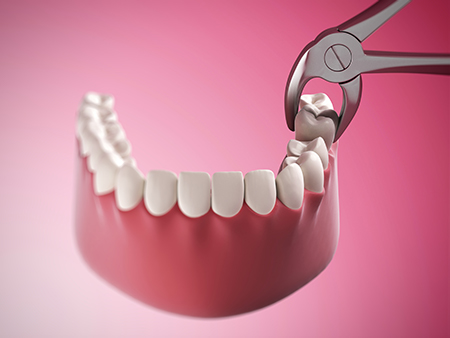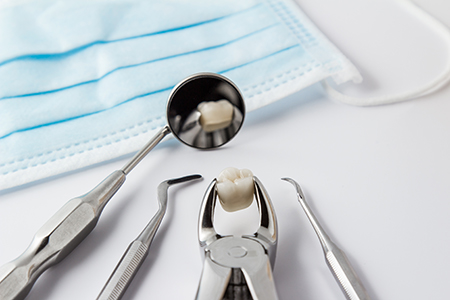
Your oral health is the priority, and sometimes preserving the natural tooth isn’t the safest option. At Seals Family Dentistry, we focus first on treatments that save teeth, but when removal is the best path forward we explain why that step protects your overall health and long-term smile. Extraction can stop ongoing pain, remove sources of infection, and prevent damage to neighboring teeth and tissues.
Decisions about extracting a tooth are never taken lightly. We begin with a careful clinical exam, relevant imaging, and a review of your medical history so that any extraction is planned with safety and predictability in mind. Where possible, we recommend alternatives and explain the pros and cons of each approach so you are comfortable with the plan.
Understanding the common reasons extractions are recommended helps people feel less anxious about the process. Below are the types of problems that often lead to tooth removal and what each situation typically involves.
Persistent baby teeth that block permanent tooth eruption
Sometimes a deciduous tooth stays in place longer than it should. If the baby tooth fails to shed naturally—because its roots didn’t resorb or it has fused to the jawbone—this can interfere with proper eruption and alignment of the permanent tooth beneath it. Removing the retained tooth can allow the underlying adult tooth to emerge correctly and support normal jaw development.
Extensive decay beyond repair
Decay that has progressed through enamel and dentin into the tooth’s core can leave too little structure to restore reliably. When a tooth is fractured by decay or the nerve is irreparably compromised, extraction removes the source of pain and infection that could otherwise spread to adjacent areas.
Severe tooth fractures
Some break patterns affect so much of the tooth or its root that rebuilding isn’t feasible. In those cases extraction may be the safest option to prevent ongoing problems and to allow thoughtful planning for replacement.
Advanced periodontal disease
When periodontal (gum) disease has destroyed supporting bone and soft tissue, teeth can become mobile and painful. Extracting non-salvageable teeth can remove an unstable element and make it easier to treat the remaining dentition and restore oral health.
Wisdom teeth that are impacted or causing harm
Third molars often lack room to erupt properly. Impacted or poorly positioned wisdom teeth can contribute to crowding, recurrent decay, or infection. Removing problematic wisdom teeth early—when appropriate—can prevent future complications.
Extractions as part of orthodontic planning
In some orthodontic treatment plans, removing selected permanent teeth helps achieve better alignment and a stable bite. These decisions are made in coordination with your orthodontist to support optimal long-term function and appearance.

A successful extraction starts long before the tooth is removed. We review your medical history, current medications, and any conditions that could affect the procedure. If you are taking medications that impact bleeding or healing, or if you have systemic conditions that require special precautions, we coordinate care with your physician as needed.
Imaging is an important part of planning. Modern digital X-rays give us clear information about root shape, proximity to nerves or sinuses, and the tooth’s relationship to surrounding bone—information that helps determine whether a straightforward extraction will work or if a surgical approach is safer.
We tailor pain control and comfort measures to each patient. Local anesthesia is standard for numbing the area; for patients with anxiety or complex needs we discuss additional options such as oral or IV sedation. When a tooth’s roots are simple and the crown is accessible, a non-surgical (simple) extraction is usually performed in the office. If a tooth is broken, ankylosed, or impacted, a surgical extraction—sometimes in collaboration with an oral surgeon—may be recommended.
Simple extractions involve teeth that are visible and have relatively uncomplicated root anatomy. Once the area is numb, the tooth is loosened and removed using forceps. This approach is efficient and predictable for most routine extractions, and we take steps to keep you comfortable throughout the procedure.
Surgical extractions are used when teeth are not readily accessible, are fractured at the gumline, or have roots with unusual shapes. The dentist or a specialist makes a small incision, and may remove a bit of bone to access the tooth. These procedures are planned carefully and include clear pre- and post-operative instructions to support smooth healing.

Every patient heals at their own pace, but there are practical steps that help most people recover comfortably. Immediately after the procedure you’ll be asked to keep pressure on the extraction site with gauze to encourage clotting. Rest and limited activity for the first 24 hours reduce the chance of bleeding and support a steady recovery.
Swelling and mild discomfort are normal and typically peak in the first 48–72 hours. Cold packs applied to the outside of the face in short intervals help limit swelling. In many cases over-the-counter pain relievers are sufficient; if stronger medication is prescribed, follow instructions carefully and avoid driving or operating heavy machinery while taking them.
Maintaining oral hygiene is important, but you’ll need to avoid vigorous rinsing or spitting in the first day or two to protect the forming clot. Gradual return to gentle brushing, followed by warm salt-water rinses as advised, helps keep the area clean without disrupting healing.
Control bleeding with gauze
Bite gently on the supplied gauze to apply steady pressure. Change the gauze when it becomes saturated and follow our guidance on how long to maintain pressure to reduce oozing.
Protect numb tissues
Until the anesthetic wears off you may not feel the area normally. Take care not to chew your cheek, lip, or tongue while sensation is diminished.
Take medications as directed
If antibiotics are prescribed, complete the entire course. For discomfort, take pain medication as recommended to stay ahead of the pain rather than waiting for it to escalate.
Avoid actions that disturb the clot
Do not rinse vigorously, use a straw, smoke, or perform heavy suction with your mouth for at least the first 48 hours to protect the healing clot.
Manage swelling
Use an ice pack on and off in the first 24 hours. Apply it for short intervals to minimize swelling and discomfort.
Modify your diet
Stick to soft, cool or lukewarm foods for a few days. Avoid hot beverages and crunchy or spicy items that could irritate the site.
Return for follow-up if needed
If stitches were placed or if healing requires monitoring, we will schedule a follow-up visit. Contact our office if bleeding, increasing pain, or unusual symptoms occur.
If you notice persistent bleeding, worsening pain, an unusual taste in your mouth, or other concerns during recovery, please contact our office so we can evaluate and assist you.

Removing a tooth can solve immediate problems, but planning for what comes after is an important part of care. Replacing a missing tooth helps maintain chewing function, supports neighboring teeth, and preserves facial contours. Common replacement options include dentures, fixed bridges, and dental implants—each has its own advantages depending on your oral health, anatomy, and goals.
Dentures can restore multiple missing teeth or a full arch and are often the most straightforward solution in certain cases. Fixed bridges use adjacent teeth for support and provide a stable, natural-feeling restoration. Dental implants are a modern option that replaces the tooth root and provides a durable, long-term foundation for crowns or bridges, closely mimicking the function of a natural tooth.
We’ll discuss timing, healing considerations, and the sequence of care so you understand when a replacement can be placed and what to expect during the process. Our goal is to identify the best path for your situation and to coordinate treatment so transitions are as smooth as possible.
We take a measured, patient-first approach to every extraction. That means clear communication, thorough planning, and personalized pain-management strategies. If you have anxiety about dental procedures, we offer supportive options and detailed explanations so you can make an informed decision about sedation or other comfort measures.
When complex needs arise, we coordinate with trusted specialists to ensure you receive the right level of care. Our team provides written instructions, schedules appropriate follow-up, and monitors healing so that recovery progresses as expected. We aim to make the experience as calm and efficient as possible from consultation through recovery.
Throughout the process, we respect your preferences and answer questions about timing, restoration choices, and preventive steps to protect the rest of your smile. At Seals Family Dentistry we strive to combine clinical skill with compassionate care so you can move forward feeling confident about your oral health.
In summary, tooth extraction is sometimes the most responsible option for removing infection, relieving pain, or creating the foundation for a healthier smile. If you have questions about whether an extraction is recommended, the technique that is best for your situation, or replacement options afterward, please contact us for more information and to discuss your personalized care plan.

The most common reasons for tooth loss include advanced periodontal disease, extensive tooth decay, and facial trauma. According to statistics, gum disease is responsible for close to 70% of tooth loss in adults. Although less frequent than the preceding three reasons, it should also be noted that specific diseases, drugs, smoking, and poor nutrition contribute to the risk of tooth loss.
The Centers for Disease Control and Prevention report that in the United States, an average of 12 teeth (including the wisdom teeth) are lost by the age of 50. Also, 26% of adults between 65 and 74 years of age have lost all their teeth.
Every patient and every situation is different. However, when a tooth and the surrounding tissues are numbed with a local anesthetic, you should only expect to feel a bit of pressure, but no pain as the tooth is being loosened from the surrounding tissues and extracted. For patients who are apprehensive and for some surgical extractions, our office will discuss our options in dental sedation to provide further relaxation and reduce any sense of discomfort.
While it's normal to feel some tenderness and swelling following an extraction, the degree of these sensations can vary. It mostly depends on the complexity of the extraction and the body's response to the procedure. We'll recommend or prescribe the appropriate pain medication to help ensure your comfort and give you specific instructions for maximum effectiveness and safety.
Typically, the recovery period following a simple extraction is shorter than a surgical extraction. However, a patient's overall health, habits, the size and location of the tooth, and other variables can influence recovery and healing. To speed up the recovery and avoid any complications, patients must follow the given at-home instructions diligently. We'll carefully review what to expect following your procedure and go over your post-op instructions.
Smoking interferes with blood clot formation, which is an essential first step in the healing process. Blood clot formation not only provides a protective layer to cover the underlying exposed bone and nerve endings, but it also supports the growth of new tissue. Cigarette smoke also contains chemical toxins that can disrupt the healing process and lead to problems such as continued inflammation, infection, or dry socket.
In a very small percentage of cases, a condition known as dry socket can develop in the aftermath of a dental extraction. This painful condition can arise when the blood clot in the extraction site doesn't form properly or gets dislodged. With dry socket, you may experience throbbing pain and symptoms such as bad breath and an unpleasant taste in your mouth. As skilled providers of care, our office will provide immediate treatment to alleviate your discomfort and promote healing.
The last teeth in your mouth to develop, wisdom teeth often do not have enough room to fully erupt or may be positioned in the wrong direction. These issues can affect your dental health as well as overall wellbeing. While some individuals never develop all their wisdom teeth, and a few have sufficient space for them, there are many people with partially or fully impacted third molars. Our office will monitor the development, position, and health of your wisdom teeth and will advise you if and when extractions are indicated.
After a tooth is removed, bone-grafting material is sometimes placed in the socket to promote healing and encourage new bone development. This procedure is often performed to support the eventual and successful placement of a dental implant.
At the office of Seals Family Dentistry, we strive to make dental care affordable and accessible. Depending on the type or complexity of the extraction and other variables, the cost of the procedure can vary. Based on our diagnostic findings, our office will inform you of the healthiest choices in care, explain the fees, discuss insurance coverage, and explain your payment options.
Many dental plans offer some level of coverage for tooth extractions. We'll advise you if your plan covers the full cost of the procedure and if there is any out-of-pocket expense. Our business office will work with you to maximize your insurance benefits as much as possible while helping you minimize any out-of-pocket expenses.

Whether you're ready to schedule your first appointment, have a question about our services, or need urgent dental care, we’re just a call or click away. Our friendly team is here to make your experience simple, stress-free, and tailored to your needs.